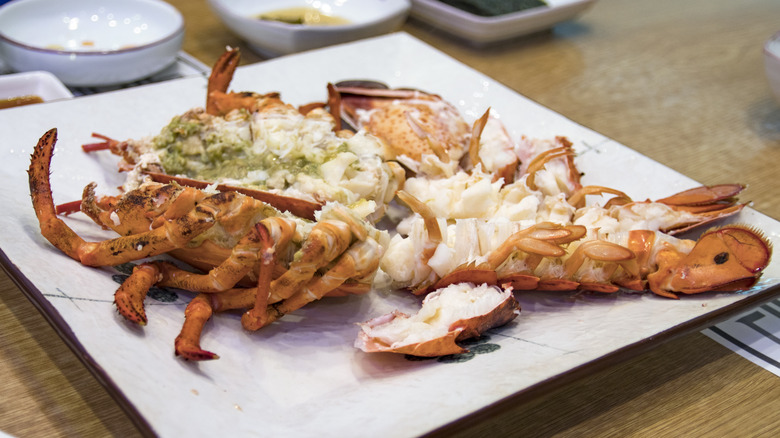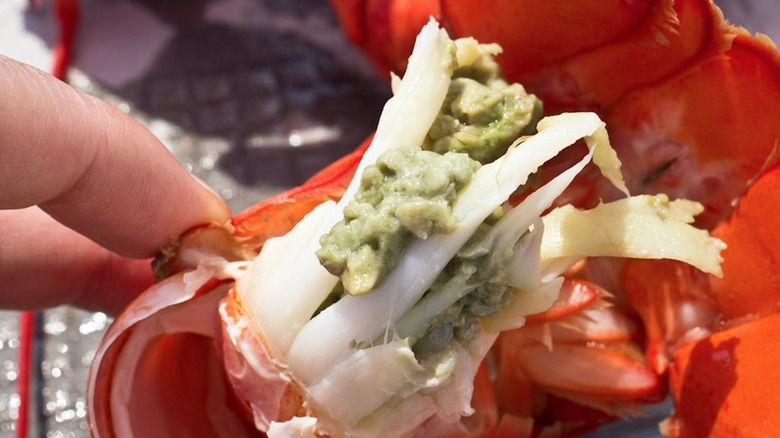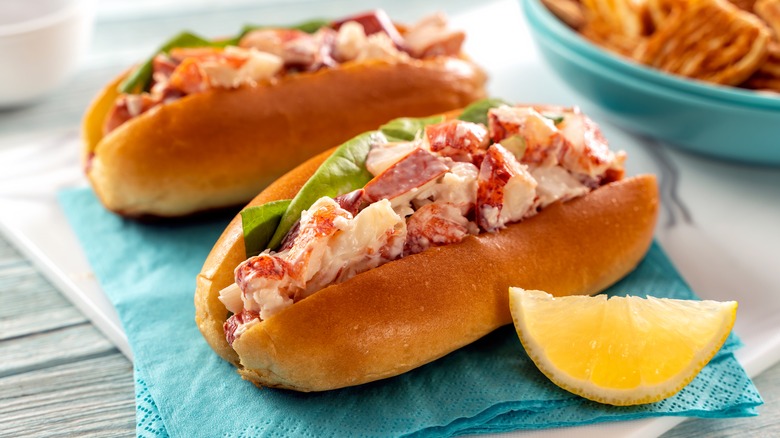What Exactly Is That Green Stuff You Find In Lobster?
Accessing the buttery-soft meat you need for a sweet lobster roll or grilled lobster tails requires first breaking it down. It can be a messy yet rewarding experience, but sometimes the lobster has a surprise in store. After opening the body cavity, you might recoil upon noticing some slimy, unappetizing green stuff in the lobster that doesn't look like it belongs. In fact, that slimy emerald goo is perfectly normal — it's the hepatopancreas, aka the tomalley of the lobster, and it's a part of its digestive tract, functioning both as its liver and pancreas.
Despite being part of the digestive system, the tomalley doesn't contain any waste or undigested food like a shrimp vein (another reason to clean your shrimp even when you're grilling it with the shell on). Like crab roe, it is considered by many – especially in New England – to be a delicacy due to its creamy texture and bold lobster flavor. However, there are some safety concerns related to consuming it.
Is lobster tomalley safe to eat?
Because the green stuff in lobster serves as a filter for the crustacean's body tissues, it can gather pollutants from its surrounding environment over time. Dioxins and mercury levels can be elevated in the tomalley, which led the Maine Center for Disease Control & Prevention to issue a warning against its consumption for children and those who are pregnant. The FDA has also cautioned against eating tomalley; in 2008, the organization stated that unusually high levels of a toxin that causes paralytic shellfish poisoning (PSP) were present in the green goo and advised folks to avoid it.
People local to where lobster is commonly harvested view these warnings as advised — particularly during red tide events, where algae blooms substantially increase the levels of toxicity in the waters — but overly cautious for healthy adults if eaten in moderation. Despite any potential concerns, many folks on the East Coast swear it's the lobster's most prized piece. The best advice to those who enjoy the New England delicacy is to only incorporate it into seafood dishes occasionally.
Some consider the green stuff in lobster a delicacy
If you were to ask a New Englander what the green stuff in a lobster is, many would enthusiastically say it is the best part of the animal. Some would even go as far as to declare you can't make a proper lobster roll without the tomalley (though this may vary depending on whether you are referring to a Maine or Connecticut-style lobster roll). The taste is rich and slightly sweet — similar to lobster meat, just amplified.
For those daring enough to try it, several notable dishes incorporate it into the recipe. Lobster bisques occasionally include tomalley, and some claim a lobster consommé wouldn't be the same without it. It can also be spread over crackers and served alongside lobster tails.
Although generally considered safe, that doesn't mean tomalley should be eaten regularly. While eating it on occasion shouldn't be a problem for most folks, it does contain more toxins than many other seafood items. Like anything else, if you are going to enjoy tomalley, do so in moderation to avoid making your own body's filters work too hard.


